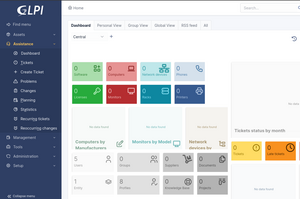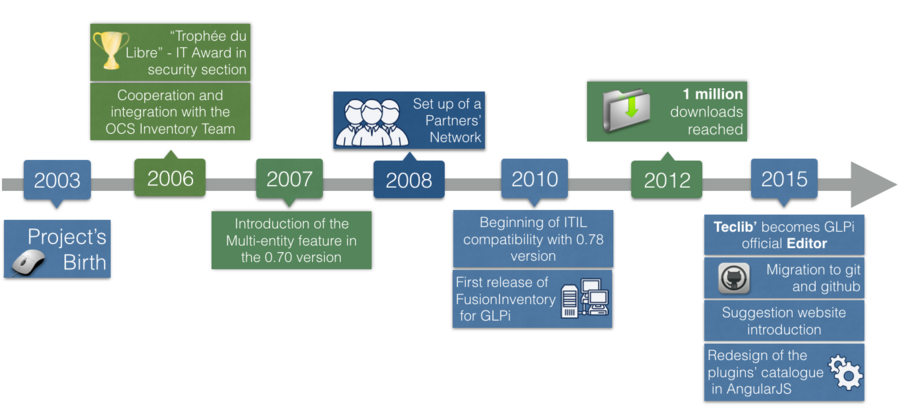GLPi
Topic: Software
 From HandWiki - Reading time: 5 min
From HandWiki - Reading time: 5 min
 GLPI home screen | |
| Original author(s) | Teclib (since 2015) INDEPNET (2003-2015) |
|---|---|
| Developer(s) | Current Developers: Teclib' & Contributors Original Developers: Jean-Mathieu Doléans, Julien Dombre & Bazile Lebeau |
| Stable release | 10.0.12
/ 1 February 2024[1] |
| Written in | PHP |
| Platform | Cross-platform |
| Type | IT asset management, Issue tracking system, Project Management & Service desk |
| License | Free software GPL v3 |
| Website | www |
GLPI (acronym: French: Gestionnaire Libre de Parc Informatique, or "Free IT Equipment Manager" in English)[2] is an open source IT Asset Management, issue tracking system and service desk system. This software is written in PHP and distributed as open-source software under the GNU General Public License.
GLPI is a web-based application helping companies to manage their information system. The solution is able to build an inventory of all the organization's assets and to manage administrative and financial tasks. The system's functionalities help IT Administrators to create a database of technical resources, as well as a management and history of maintenances actions. Users can declare incidents or requests (based on asset or not) thanks to the Helpdesk feature.[3]
History
The GLPI Community based-project started in 2003 and was directed by the INDEPNET association.[4] Through the years, GLPI became widely used by both communities and companies, leading to a need of professional services around the system. Whereas the INDEPNET[5] Association did not intend to offer services around the software, in 2008 the Association created a Partners' Network in order to achieve various objectives:
The first objective was to build an ecosystem where Partners could participate in GLPI Project. Secondly, Partners would financially support the association, in order to ensure the necessary software development. And finally, the ecosystem would guarantee a service delivery through a known and identified Network, directly connected to INDEPNET.
In 2009, Teclib’ started to integrate the software, developed the GLPI code and implemented new features. During summer 2015, the GLPI's Community leaders decided to transfer the roadmap management and the development leadership to Teclib’, so that Teclib´becomes editor of the GLPI system ensuring the software R&D.[6]
The code remains under a GPL license and keeps its open source nature. The GLPI system continues to be improved thanks to the co-partnership between the community and the editor.
Timeline
Software development
GLPI Project is an open source and collaborative community of developers and IT experts gathered to develop the GLPI software. This collaboration is achieved by different means: installation and use of GLPI, GLPI tests, upgrades submissions, documentation participations, translations, features request.
Agents
The most uses agent for GLPI is Fusion Inventory
| Date | Release |
|---|---|
| February 14th, 2023 | GLPI 10.0.6 + 1.1 |
Major releases
Since 2003, GLPI has been developed through more than 80 versions. Major releases include:[7]
| Date | Release |
|---|---|
| January 24th, 2023 | GLPI 10.0.6 |
| April 20th, 2022 | GLPI 10.0.0 |
| July 7th, 2020 | GLPI 9.5.0 |
| February 11th, 2019 | GLPI 9.4.0 |
| June 28th, 2018 | GLPI 9.3 |
| September 25th, 2017 | GLPI 9.2 |
| September 23rd, 2016 | GLPI 9.1 |
| October 9, 2015 | GLPI 0.90 |
| November 12, 2014 | GLPI 0.85 |
| August 9, 2013 | GLPI 0.84 |
| April 4, 2012 | GLPI 0.83 |
| May 26, 2011 | GLPI 0.80 |
| October 12, 2010 | GLPI 0.78 |
| July 15, 2009 | GLPI 0.72 |
| July 11, 2008 | GLPI 0.71 |
| December 21, 2007 | GLPI 0.70 |
| July 28, 2006 | GLPI 0.68 |
| March 29, 2006 | GLPI 0.65 |
| September 20, 2005 | GLPI 0.6 |
| April 29, 2005 | GLPI 0.5 |
| November 17, 2003 | GLPI 0.2 – 1st Version |
Software overview
As an ITSM software, the main features of GLPI are the following:
- Multi-entity management
- Multilingual management and support (45 languages available)[8]
- Multi user support and Multiple Authentication System
- Administrative and Financial management
- Inventory functionalities
- Incident and request management tracking and monitoring features
- Problem and change management
- Licenses management (ITIL compliant) [9]
- Assignment of equipment: location, users and groups
- Simplified interface to allow end users to fill a support ticket
- Asset and helpdesk reports: hardware, network or interventions (support)
Specific features
| Features | Characteristics[10] |
|---|---|
| Inventory | Inventory of computers, peripherals network printers and associated components through an interface with OCS Inventory or FusionInventory [11] |
| Business management, contracts, documents related to inventory items | |
| ITIL Compliant ServiceDesk | Management of issues on many environments through creation of tickets, management of tickets, assignment, tickets scheduling, etc. |
| Problem, project and changes management | |
| End Users | Intervention history |
| Satisfaction survey | |
| Request comment | |
| Mail tracking of intervention demands [12] | |
| Technicians | Intervention demands management |
| Ticket escalation | |
| Statistics | Reports in various formats (PNG, SVG, CSV) |
| Global statistics | |
| Categories statistics (by technician, hardware, user, category, priority, location …) | |
| Management[13] | Equipment status management and booking |
| Contracts and Documents management | |
| Basic system of knowledge database management | |
| Management of applications for assistance of all types of equipment inventory | |
| Management of business and financial information (purchase, guarantee and extension, damping) | |
| Reservation[14] | Reservation management |
| User interface (calendar) | |
| Knowledge Database | Knowledge base articles and FAQ management[15] |
| Content management by targets (profiles, groups, etc.) | |
| Reports | Devices Report generation (device-type, associated contract, commercial information) |
| Projects | Manage projects. You can associate users, groups, companies, Assets, contacts. documents, contracts and items. They will be used for the creation of tasks linked to the project. You can create sub-projects and associate them to a parent project. The projects it is available as Gantt type trees and graphics. |
Moreover, GLPI has many plugins that add further features.[16]
Distribution
GLPI Software can be installed and set up in two different ways, either through the community forge or through a professional network.[17]
Technologies used
GLPI is using the following technologies:
- PHP 7.4 or higher[18]
- MySQL / MariaDB regarding the database[19]
- HTML for the Web pages
- JavaScript for some core functionalities
- CSS respecting style sheets
- XML for report generation
See also
- IT asset management
- Issue tracking system
- Comparison of help desk issue tracking software
- Comparison of ticket-tracking systems
- Service desk
- OCS Inventory
References
- ↑ "GLPI 10.0.12". 1 February 2024. https://glpi-project.org/glpi-10-0-12/.
- ↑ "GLPI installation" (in en). 2018-03-01. https://glpi-install.readthedocs.io/.
- ↑ "Help-desk Ticketing System - Install GLPI (IT and Asset Management) Tool with Fusion Inventory in Debian Linux". 13 May 2015. http://www.tecmint.com/glpi-it-asset-management-with-fusion-inventory-in-debian-linux/.
- ↑ "GLPI est un outil d'inventaire de parc informatique et de Helpdesk, lancé en 2003 et porté par Julien Dombre, Jean-Mathieu Doléans et Bazile Lebeau - GLPI / Guide Open Source" (in fr). http://www.open-source-guide.com/Solutions/Infrastructure/Gestion-de-parc-et-d-inventaires/Glpi.
- ↑ INDEPNET, Association. "Association INDEPNET" (in fr). http://www.indepnet.net.
- ↑ "GLPI : les porteurs du projet associatif passent la main à Teclib' par Philippe Scoffoni" (in fr). 2015-09-14. https://philippe.scoffoni.net/glpi-porteurs-projet-associatif-passent-main-teclib/.
- ↑ "GLPI - Gestionnaire libre de parc informatique". http://www.glpi-project.org/?page=annonce&lang=en.
- ↑ "Multilingual support with 45 languages available - Install GLPI on Debian 7". 2016-01-05. https://www.rosehosting.com/blog/install-glpi-on-debian-7/.
- ↑ "via les principes ITIL - GLPI : Installation et configuration" (in fr-FR). 2016-04-04. http://www.oameri.com/glpi-installation-configuration/.
- ↑ "GLPI characteristics - GLPI - Gestionnaire libre de parc informatique". http://glpi-project.org/spip.php?article53.
- ↑ "L'onglet "Inventaire" donne accès à toutes les informations concernant le matériel Présentation de GLPI | SUPINFO, École Supérieure d'Informatique". http://www.supinfo.com/articles/single/1382-presentation-glpi.
- ↑ "Job-tracking-system with mail - GLPI". https://www.qnap.com/i/en/app_center/con_show.php?op=showone&internalName=glpi&version=0.85.3&down_1_name=TS-NASX86&jump_win=1.
- ↑ "Description des menus de GLPI : Le menu ADMINISTRATION" (in fr). 2010-06-04. http://vpourchet.com/2010/06/04/description-des-menus-de-glpi-le-menu-administration/.
- ↑ "Gestion des réservations de matériels". http://www.commentcamarche.net/download/telecharger-34055164-glpi.
- ↑ "Ce logiciel peut gérer un système de base de connaissances hiérarchique FAQ - GLPI : gestion de parc informatique avec helpdesk". https://www.projet-plume.org/fiche/glpi.
- ↑ "GLPI plugins portal". glpi project. http://plugins.glpi-project.org/.
- ↑ "GLPI Network ITSM Software | Teclib'". http://www.teclib-edition.com/teclib-products/glpi-network-itsm/.
- ↑ "Prerequisites — GLPI 9.5 documentation". https://glpi-install.readthedocs.io/en/latest/prerequisites.html#php.
- ↑ "Prerequisites — GLPI 9.5 documentation". https://glpi-install.readthedocs.io/en/latest/prerequisites.html#database.
Further reading
- Antal, Barzan "Tony" (2010). "7: Integrating OCS-NG with GLPI". OCS Inventory NG 1.02. Packt. ISBN 978-1-84951110-0. http://my.safaribooksonline.com/book/databases/content-management-systems/9781849511100/integrating-ocs-ng-with-glpi/ch07.
- Patrice, Thebault (in French). GLPI (Gestion Libre de Parc Informatique) : Installation et configuration d'une solution de gestion de parc et de helpdesk. ENI. ISBN 978-2-7460-7008-0.
- Prodromou, Evelthon (2009). At Your Fingertips - Managing resource information in GLPI. http://www.linux-magazine.com/Issues/2009/103/AT-YOUR-FINGERTIPS/(kategorie)/0%20linux-magazine.com.
External links
 |
 KSF
KSF
